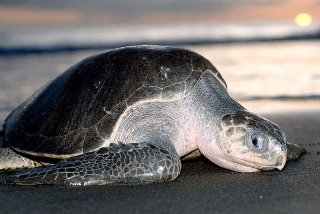An olive ridley turtle was near death and stranded on the shores of Oregon, USA. Since his rescue, he has been receiving treatment traditionally used to cure divers suffering from the bends. Tucker, as his carers at the Seattle Aquarium affectionately call him, was a long way from his usual ‘stomping grounds’, the warm waters of the Pacific coast of Mexico.
 Threatened sea turtle saved from death’s door
Threatened sea turtle saved from death’s door
Tucker could not submerge due to gas bubbles that caused buoyancy issues. Floating on the oceans surface, he was carried into the cold waters that olive ridleys are not accustomed to. He was near starving and his body temperature was half of what it should be, causing most of his organs to shut down. His fortune turned when he washed up on Cannon Beach.
The Seattle Aquarium veterinary team began the mammoth task to ‘bring him back to life’ . This included treating him for severe pneumonia by providing manual ventilation by pressing a bulb on a tube in his mouth every two minutes for a week! His body temperature was painstakingly raised by 2 degrees a day and he was hand fed about a kilogram of seafood, including anchovies, shrimp and squid daily. Once he had recovered sufficiently he was the first non-human to be treated in the hyperbaric chamber at Seattle’s Virginia Mason Hospital. A team of hospital staff and veterinarians from the aquarium prescribed the hyperbaric therapy. This included 2 ½ hours in the chamber while being sedated and breathing 100% oxygen through a breathing tube in his airway.
Collaboration between doctors and veterinarians – a win for conservation!
Two members of the team shared their unusual experience. Dr James Holm, Medical Director at the Centre for Hyperbaric Medicine and scuba diver for over 40 years: “We have treated many scuba-divers over the years… this is the first time we have been asked to assist in the care of a sea turtle, which are excellent divers themselves.”
Aquarium veterinarian, Lesanna Lahner said: “Not only will the treatment potentially help him to be released back into the wild, but it has provided us with valuable information about the diving physiology of sea turtles, as we were able to closely monitor his vitals and blood gases throughout the entire procedure. This has been an exciting collaboration of veterinary medicine and human healthcare providers.”
Tucker’s recovery is being carefully monitored at the aquarium. It is vital that his buoyancy returns to normal so he can submerge, will not be vulnerable to predators or boats and can find food. When his team of carers are confident that he has fully recovered, he will be flown to San Diego and released into the Pacific ocean.
Experience olive ridley turtles and other amazing marine life in the waters off Mexico.
Book your Socorro Island and Sea of Cortez liveaboard diving cruise now.
Contact Dive The World right away on +66 (0)94 582 7973 / (0)83 505 7794 or send us an email.